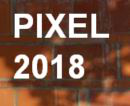Speaker
Description
In conventional method of Compton imaging, only the information of gamma rays is used to estimate the location of radiation source. However, because of the information deficiency of recoil electrons occurred in Compton scattering process, signal-to-noise ratio (SNR) and angular resolution will be reduced. Recently, deep learning has become an increasingly important hot pot. With deep learning, the correct label of recoil electrons energy deposit image is made and divided into practice data for learning and test data for prediction. With the prediction results of direction vector and scatter plane deviation (SPD), the imaging of recoil electrons is carried out.
Based on it, we explore a new approach for recoil electrons tracking using trigger-mode Silicon-On-Insulator (SOI) sensor with a pitch of 36μm which named XPRIX6c. The XRPIX series is one of the “SOIPIX” detector, which is an active pixel sensor based on SOI complementary metal-oxide-semiconductor (CMOS) pixel technology [1]. XPRIX6c consists of 48×48 pixels, and each pixel has a charge integration circuit and trigger circuit [2][3]. The ejected direction of a recoiled electron is detected on the SOI pixel detector. And then, using Geant4, 137Cs whose energy is 662keV was simulated to get the data of recoil electrons trajectories. In this simulation, the distance of source and detector was 5cm and 200 files of which each contained more than 700 Compton scattering information was used for deep learning. Through the combination, the ejected direction in three-dimension can be identified and the accuracy of imaging can be improved.
We obtained the recoiled electron trajectories of 137Cs with trigger-mode SOI pixel detector and through deep learning, we did prediction to get more accurate imaging. We will show the results.
References
[1] Yasuo Arai, et al. Development of SOI pixel process technology, Nuclear Instruments and Methods in Physics Research Section A 636 (2011) S31
[2] Ayaki Takeda, et al. Improvement of spectroscopic performance with Double-SOI pixel detectors for an X-ray astronomy. Journal of Instrumentation 10.06 (2015)
[3] Shinya Nakashima, et al. Progress in development of monolithic active pixel detector for X-ray astronomy with SOI CMOS technology. Physics Procedia37 (2012): 1373-1380.
